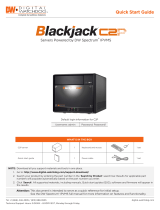
Recommended Specs for the Full Client
Processor Intel Core i5 or greater
Video Card
Intel HD Graphics 2500 (or higher) with 1GB Dedicated Memory
Recommend NVIDIA or AMD graphics card with 2GB or more memory
Resolution 1920 x 1080
RAM 16GB
NIC 1Gbps Ethernet
OS Supported
– Client
Windows
7 Home, 7 Standard, 7 Pro, 7 Ultimate, 8/8.1 Standard, 8/8.1 Pro, 8.1
Enterprise, 10 Home/Pro/Enterprise**
Windows Servers*
Any versions of 2008, any versions of 2008 R2, any versions of Server
2012, any versions of Server 2012 R2
Linux Ubuntu 14.04, Ubuntu 16.04
Mac OSX 10.11, OSX 10.12
SYSTEM REQUIREMENTS
Linux OS
www.digital-watchdog.com
sales@dwcc.tv
Rev Date: 01/19
Copyright © Digital Watchdog. All rights reserved.
Specifications and pricing are subject to change without notice.
Tel: +1 (866) 446-3595
Fax: (813) 888-9262
TROUBLESHOOTING TIPS
Problem Possible Solutions
My camera does not
auto-discover
1. Is the camera in the same LAN network as the Media Server?
2. Is your camera compatible with DW Spectrum? (Refer to our website for full list of supported cameras.)
3. Is the camera updated to its latest firmware?
4. If your camera is integrated with DW Spectrum via ONVIF, make sure ONVIF is enabled on your camera.
5. Try adding the camera manually.
6. Try rebooting the server after installation. Allow up to 2 minutes for the server to map your network and
detect all supported devices.
Videos are slow
1. Are you accessing the same cameras from multiple clients? (LAN & WAN)
2. Do you have a Gigabit network? Check your network speed.
My camera appears
disconnected
1. Under camera settings, make sure the user name and password are correct.
2. Under the camera settings, use the ‘Ping’ button to make sure the camera is connected to the network
properly.
3. If you can connect to the camera’s web viewer, try rebooting the camera and/or restore it to factory
default.
4. Make sure your camera is using the latest firmware available.
5. Make sure that the camera is connected to the same network as the server.
6. If you are connecting to a camera that is integrated with DW Spectrum via the ONVIF protocol (see list),
make sure ONVIF is enabled.
7. Make sure your user has permissions to view that specific camera.
I can’t get playback
video from my
camera
1. Do you have network connection between client and server (in case server and client are not on the same
machine)?
2. Make sure your user has playback viewing permissions for the selected channel.
3. Make sure the camera is set to a recording mode that would provide recorded video for the selected time
and environment.
4. On the server side, check the media server log to make sure the camera you are trying to watch has not
been unexpectedly disconnected.
I get an
‘unauthorized’
message on my
camera
1. Make sure the camera’s user name and password are properly entered in the camera’s general information
under the camera settings menu.
2. If necessary, try rebooting the camera to apply the camera’s user name and password.
* Except Storage Server version
Important: OS not listed will be not be supported by DW
®
Tech Support































